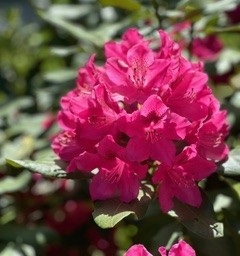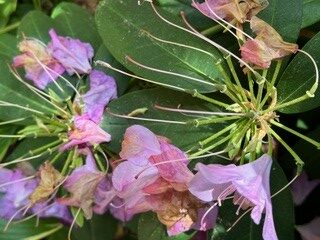Do not drive or park on the lawn. Soil compaction by heavy equipment or foot traffic in the plant’s root zone reduces the pore space for air in the soil. Percolation of moisture through the soil is disrupted so that the desirable air/moisture balance is not maintained. Roots die from a lack of oxygen.
Mulch landscape plants with organic mulches. Mulch provides many benefits, including moisture retention, control of fluctuations in soil temperature, weed suppression, and protection from mechanical damage from line trimmers and lawn mowers. Organic mulches such as bark mulch look attractive and help with the addition of organic matter to the soil through decomposition. Remove established perennial weeds before mulch is applied. Avoid mulch depths greater than four inches and do not allow mulch to contact the base of trees and shrubs. Avoid “mulch volcanoes”, the term used to refer to mulch piled harmfully high around the base of a tree or shrub.
Most plants (lawns, vegetables, perennials, annuals, trees and shrubs) need one inch of water per week. It is better to water with one or two deep waterings per week than to water lightly each day, which encourages shallow rooting. Digging down into the soil is the best way to determine if enough water is received for lawns, which means typically amounts of 6” deep for lawns, 8” for gardens, and 10” for trees and shrubs. Install a rain gauge to monitor theamount of water the plants receive. Check the Water Supply District of Acton website for this year’s watering regulations.
Finish planting by the end of this month so that plants can begin to establish themselves before the hottest weather arrives.

Annuals and perennials will keep a steady bloom performance if their faded flowers are continually removed, preventing seed formation.
Pinch fall asters and chrysanthemums until the beginning of July, to produce bushy plants with many flowers. Stake tall plants before they fall over.
Remove faded flower heads from rhododendrons which are now forming seeds. Be careful, as new shoots are found on either side of the old flower heads.

Wait for bright green new growth to harden off before pruning evergreens in July and August.
June is a good month to move your houseplants outside. Many houseplants prefer dappled shade or protection from midday and early afternoon sun. This is a good time to repot them into larger, clean pots using a soilless growing media.
Prune spring flowering shrubs such as forsythia (Forsythia spp.), rhododendron and azalea (Rhododendron spp.), Virginia sweetspire (Itea virginica), mock orange (Philadelphus spp.), ninebark (Physocarpus opulifolius), spring blooming spirea (Spirea), lilacs (Syringa spp.) and(Viburnum spp.) after bloom for maximum flower display next year. These shrubs will form their flower buds on this year’s stem growth for next spring.
Judy Dembsey is the chair of environmental education and a member of the board of the Acton Garden Club.













